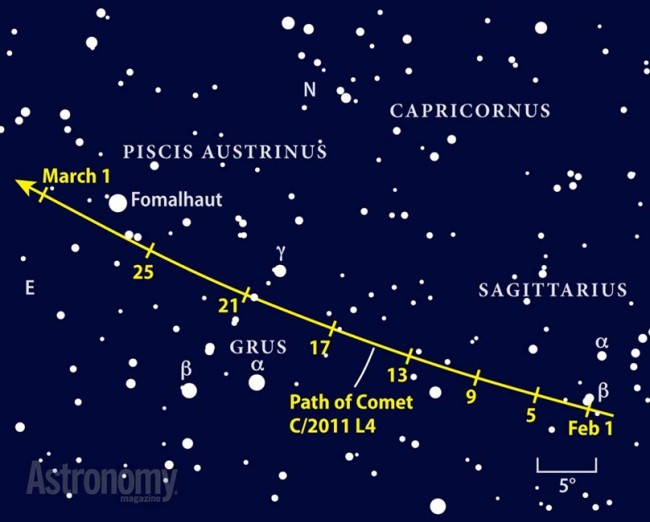Comet-finder-chartAs Comet PANSTARRS makes its first trip through the inner solar system, it could brighten to naked-eye visibility late in February for observers in the Southern Hemisphere. // Astronomy: Roen Kelly
Southern-sky viewers have all the luck this month.
By Michael E. Bakich — Published: January 31, 2013
As February opens, Comet PANSTARRS (C/2011 L4) is acting the way many comets do — unpredictably. Astronomers at the University of Hawaii discovered this object June 7, 2011. By now, it should have reached a brightness that would let observers from a dark site see it without optical aid. And although the comet is visible through even small binoculars, it unfortunately isn’t living up to predictions.
Comet PANSTARRS currently glows at approximately magnitude 7. Astronomers use the magnitude system to describe the brightness of any celestial object; the smaller the number, the brighter the object. Most people can see a magnitude 6 star from a dark site without optical aid. But, unlike a star, a comet is an extended object, so its brightness spreads out a bit. To reach naked-eye visibility, Comet PANSTARRS will have to rise fivefold in brightness, which, hopefully, will happen in about a week.
On February 1, the comet lies in the obscure constellation Telescopium, and it is visible only to those who live in southern latitudes. On that date, from latitude 30° south (the approximate position of Santiago, Chile, and Perth and Sydney, Australia), Comet PANSTARRS will stand 15° above the southeastern horizon at the start of morning twilight. And it will lie 10° or more above the horizon through the 13th. Unfortunately, the comet will remain invisible to Northern Hemisphere observers throughout February.

So, if you live far enough south, to find Comet PANSTARRS in the morning sky February 1, look 1.5° southeast of the brighter of the two suns that make up the double star Arkab, also known as the Beta (β) star in the constellation Sagittarius the Archer. Through binoculars or a telescope, you’ll see what looks like a cotton ball with a short tail pointing to the southwest. On the 26th, the comet will lie less than 3° east-southeast of the brilliant star Fomalhaut in the constellation Piscis Austrinus the Southern Fish.
Those eager amateur astronomers who live at latitude 40° north will begin to see the comet in the morning sky in mid-March. Veteran comet-watcher and Astronomy Contributing Editor Raymond Shubinski points out an important fact: “Although the comet may be disappointing to the eye, point a camera — or, better yet, a camera attached to a telescope — at it, and the detail you capture may surprise you.”
Both photographers and visual observers are hoping that the comet will fool predictors once again and rise to a brightness that makes it an easy catch under a dark sky. So, stay tuned to Astronomy.com for Comet PANSTARRS updates.

